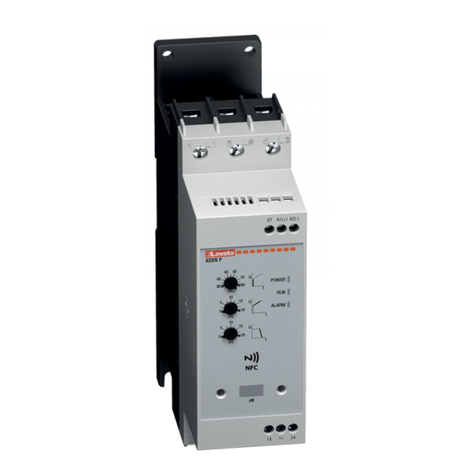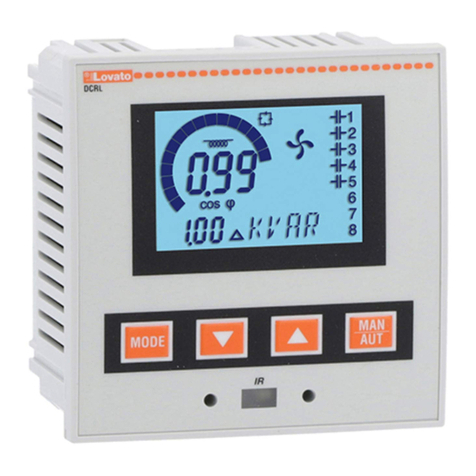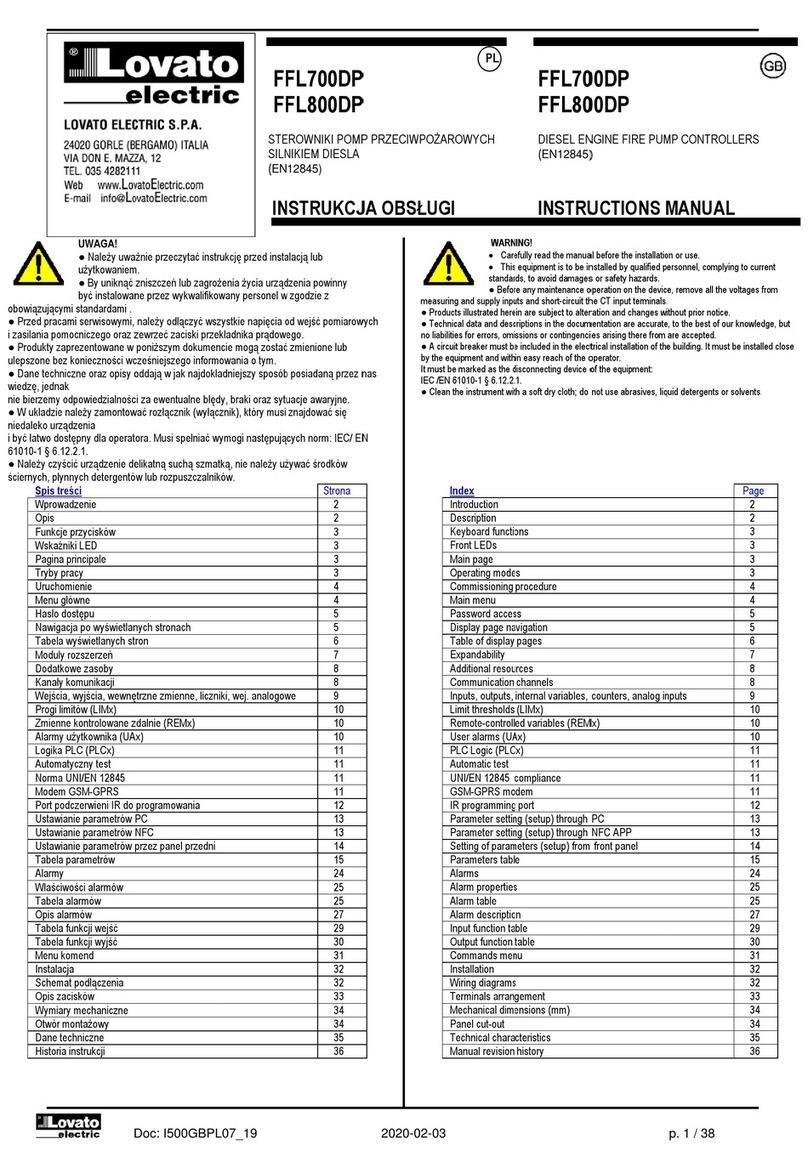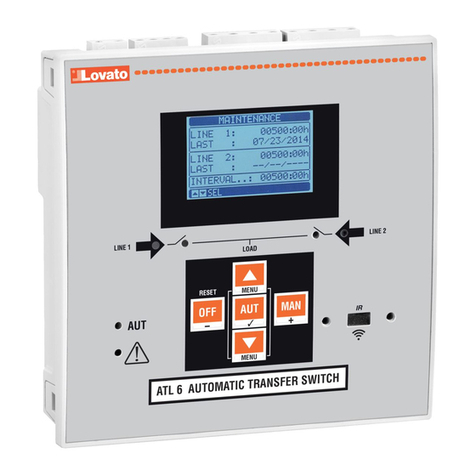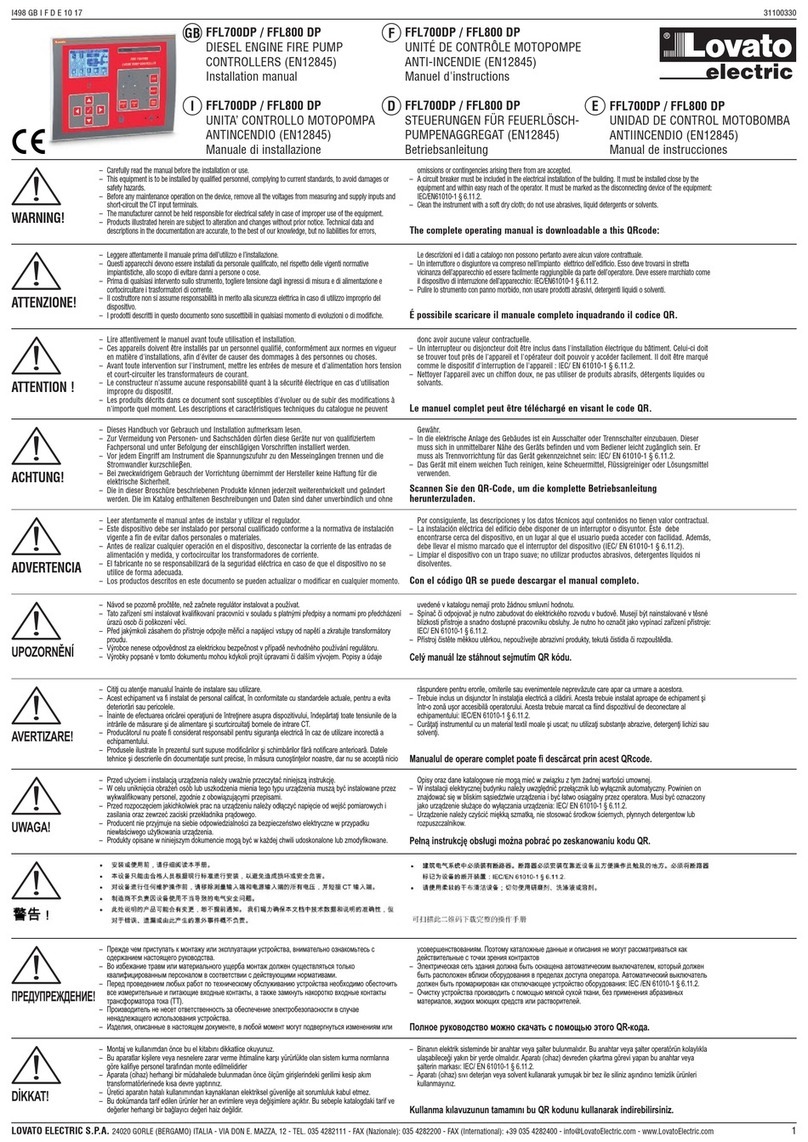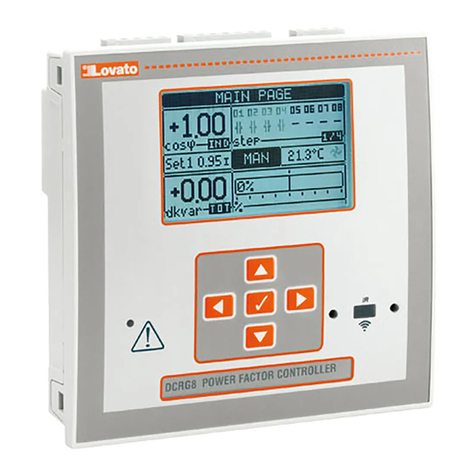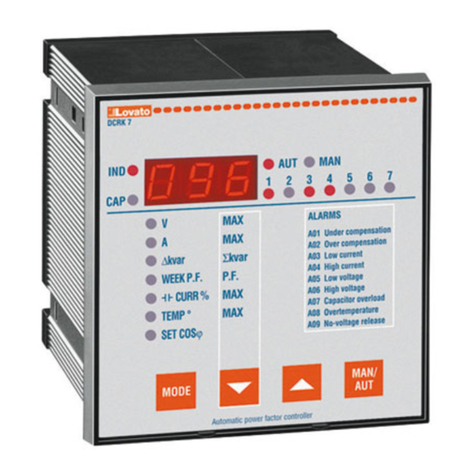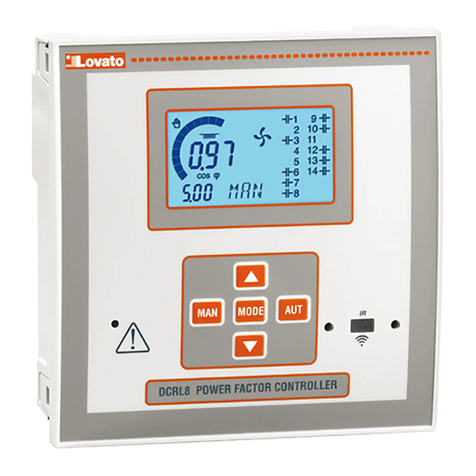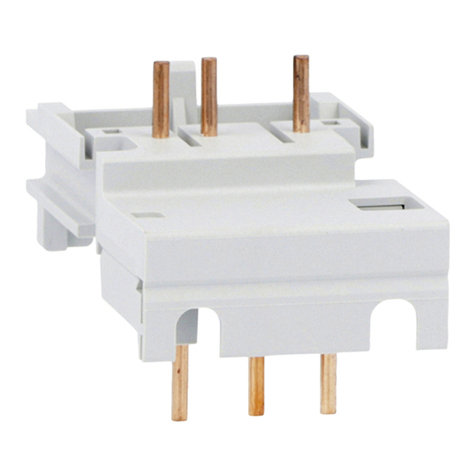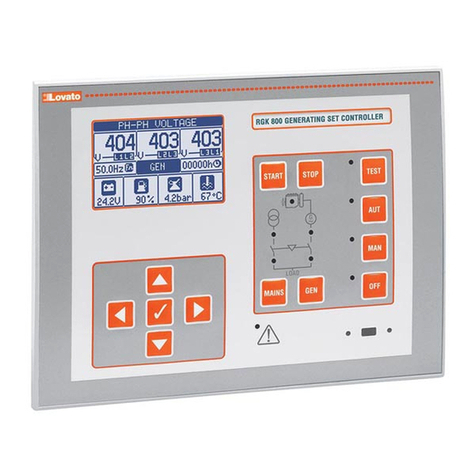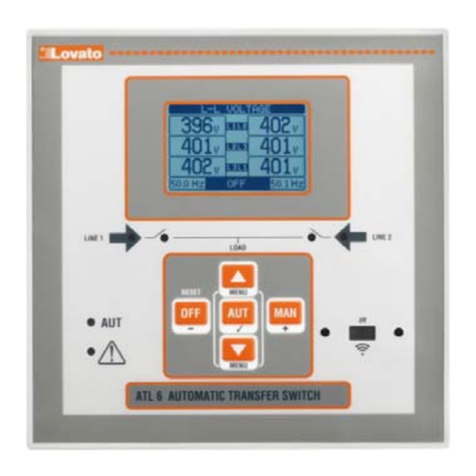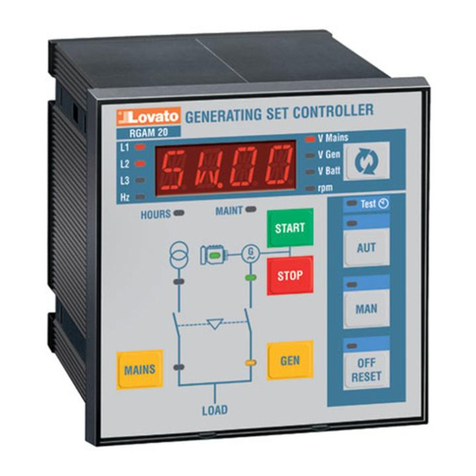
I193 I GB PL 05 11 31100057
5
MODALITA’ TEST
– La modalità TEST consente di verificare il
corretto funzionamento del gruppo
elettrogeno anche in condizioni di
normale presenza della linea prioritaria.
– Passando in TEST il gruppo elettrogeno
sulla linea secondaria viene
immediatamente avviato.
– I controlli di tensione sono entrambi
attivati, e se durante la prova si verifica
una anomalia sulla linea prioritaria, il
carico viene commutato in modo
automatico.
– In condizioni normali di presenza linea
prioritaria, il carico rimane su di essa ed il
gruppo elettrogeno funziona senza carico
(test off-load).
– Se si desidera commutare il carico sul
generatore (test on-load), premere
contemporaneamente il tasto E(TEST) ed
il tasto D(ON-OFF linea 2) per 5 secondi.
– In TEST, una volta che il carico è stato
commutato sul generatore, sia per una
mancanza sulla linea prioritaria sia per un
test on-load, esso non ritorna più
automaticamente sulla linea prioritaria, a
meno di passare in modalità AUT.
– I tempi di ritardo ed interblocco sono i
medesimi della modalità automatico.
SIMULAZIONE MANCANZA LINEA
PRIORITARIA
– Partendo dalla modalità AUT, è possibile
effettuare una simulazione di una
mancanza di tensione sulla linea
prioritaria della durata di 1 min.
– L’apparecchio reagirà utilizzando lo
stesso comportamento e le stesse
tempistiche impostate per il normale
funzionamento automatico. Sarà così
possibile verificare il corretto
funzionamento dei cicli di trasferimento.
– Partendo dalla modalità AUT, premere il
tasto AUT ed il tasto ON-OFF linea 2
contemporaneamente per 10 secondi
consecutivi.
– Sul display comparirà la scritta F.SI
(Failure Simulation) durante l’esecuzione
di tutto il ciclo.
– Per terminare anticipatamente la prova,
ripetere la procedura di avvio o passare in
modalità OFF - RESET.
APPLICAZIONE RETE-GENERATORE
– Nell’applicazione rete-generatore (U-G,
impostazione di default) il carico è
normalmente collegato alla rete (Linea 1).
In seguito ad una anomalia di tensione o
frequenza, dopo il tempo di ritardo P2.15,
viene mandato un segnale di start al
generatore (Linea 2).
– Quando la tensione del generatore rientra
nei limiti programmati, il carico viene
commutato sul generatore.
– Quando la rete ritorna normale il carico
viene ricommutato, ed il generatore viene
mantenuto in moto senza carico per un
tempo definito da P2.16 in modo da
consentirne il raffreddamento.
– La centralina ATL invia al generatore un
comando di start/stop attraverso una
uscita a relè e può ricevere dei segnali
digitali dal generatore che ne indicano lo
stato (generatore pronto, ok alla presa del
carico ecc) attraverso degli ingressi
programmabili.
– E’ possibile programmare un test
automatico, cioè avviare periodicamente il
generatore per verificarne il
funzionamento anche se la rete è
normalmente nei limiti, definendo
intervallo di esecuzione, ora di partenza,
quali giorni della settimana effettuare il
test, la sua durata ecc. Fare riferimento
all’apposito menu per l’impostazione del
test automatico.
TEST MODE
– The TEST mode allows to control the
proper operation of the generating set
also under standard presence conditions
of the main line.
– When shifting to TEST, the generating set
on the secondary line is immediately
started.
– Both voltage controls are activated and, if
an anomaly occurs on the main line
during the test, the load is switched over
automatically.
– Under standard conditions of main line
presence, the load remains on the line
and the generating set works with no load
(off-load test).
– If you want to shift the load to the
generator (on-load test), press key
E(TEST) and key D(line 2 ON-OFF)
together for 5 seconds.
– In TEST mode, once the load has been
shifted to the generator, either due to a
main line failure or to perform an on-load
test, it does not automatically return to
the main line, unless you switch to AUT
mode.
– Delay and interlock times are the same as
in the automatic mode.
MAIN LINE FAILURE SIMULATION
– Starting from the automatic mode, it is
possible to simulate a 1-minute voltage
failure on the main line.
– The unit will respond in the same manner
and timeframe set for standard automatic
operation. The proper operation of
transfer cycles may thus be controlled.
– Starting from AUT mode, press the AUT
key and the line 2 ON-OFF key together
for 10 consecutive seconds.
– The letters F.SI (Failure Simulation) will
be shown on the display during the whole
cycle operation.
– To stop the test before completion, repeat
the starting procedure or switch to
OFF - RESET mode.
UTILITY-TO-GENERATOR APPLICATION
– In the utility-to-generator application
(U-G, default setting) the load is usually
connected to the utility (Line 1). Following
voltage or frequency anomaly, after the
delay set in P2.15, a start signal is sent to
generator (Line 2).
– When generator voltage is within
programmed limits, the load is connected
to the generator end until the utility line
returns within standard values.
– At this time, the load is transferred back
and the generator is kept in operation
without load for a time set by P2.16 to
allow it to cool.
– The ATL controller sends a start/stop
command to the generator through a
relay output and can receive digital
signals from the generator indicating its
status (generator ready, ok to load taking,
etc) through programmable inputs.
– An automatic test can be programmed,
i.e. the generator can be started at set
times to control its operation even if the
utility is generally within limits, by setting
run interval, starting time, days of the
week when the test shall be carried out,
its duration, etc. Refer to the relevant
menu to set the automatic test.
TRYB: TEST
– W trybie TEST użytkownik ma możliwość
sprawdzenia właściwego funkcjonowania
agregatu prądotwórczego, nawet
w przypadku obecności linii głównej.
– Po wciśnięciu przycisku TEST wysyłana
jest natychmiast komenda do
uruchomieniaagregatu prądotwórczego.
– Parametry napięcia obu linii
są kontrolowane i gdy na linii głównej,
podczas testu, pojawią się jakiekolwiek
anomalie to obciążenie przełączane jest
automatycznie.
– W normalnych warunkach obciążenie
pozostaje podłączone do linii głównej
a agregat prądotwórczy pracuje bez
obciążenia (test z odłączonym
obciążeniem).
– Jeśli chcemy przełączyć obciążenie
do agregatu prądotwórczego (test
z obciążeniem) to należy jednocześnie
wcisnąć przyciski E(TEST) i D
(linia 2 ON-OFF) przez 5 sekund.
– W trybie TEST, gdy obciążenie zostało
przełączone do agregatu, albo ze względu
na błąd linii głównej albo z powodu
wykonywania automatycznego testu
z obciążeniem, nie powróci automatycznie
do linii głównej, chyba, że zostanie
zmieniony tryb pracy na AUT.
– Czasy opóźnienia i blokady przełączania
są takie same jak w trybie
automatycznym.
SYMULACJA ZANIKU LINIIGŁÓWNEJ
–W trybie automatycznym istnieje
możliwość symulacji 1 minutowego
zaniku napięcia na linii głównej.
– Sterownik będzie pracować i reagować
w tych samych ramach czasowych jak
w trybie automatycznym, dlatego
prawidłowe przełączanie może być
kontrolowane.
– W trybie automatycznym należy wcisnąć
jednocześnie przyciski AUT i ON-OFF
(linii 2) przez 10 sekund.
– Podczas całego cyklu symulacji na
ekranie wyświetlone zostaną litery F.SI.
– By zakończyć test przed jego
ukończeniem należy powtórzyć procedurę
rozruchu lub przejść w tryb OFF-RESET.
APLIKACJA: SIEĆ - AGREGAT
– W aplikacji sieć – agregat (aplikacja
domyślna, U-G) obciążenie, normalnie,
jest podłączone do linii głównej (linia 1).
W przypadku wystąpienia anomalii
napięcia lub częstotliwości, po upływie
opóźnienia ustawionego w parametrze
P2.15, sterownik wysyła sygnał
uruchomienia agregatu (linia 2).
– Kiedy napięcie agregatu prądotwórczego
osiąga zaprogramowane limity, obciążenie
jest przełączane do agregatu i pozostaje
podłączone tak długo, aż parametry linii
głównej nie powrócą w granice limitów.
– Kiedy parametry sieci powrócą w granice
limitów to obciążenie jest przełączane
do sieci a agregat nadal pracuje, już bez
obciążenia, przez czas potrzebny do
wychładzania ustawiony w parametrze
P2.16.
– Sterownik wysyła komendę
rozruchu/zatrzymania agregatu przez
wyjście przekaźnikowe i odbiera sygnał
cyfrowy z agregatu, wskazujący na jego
status (np. agregat gotowy, możliwe
przejęcie obciążenia, itp.) przez
programowalne wejścia.
– W sterowniku można zaprogramować
automatyczny test, to jest agregat będzie
uruchomiony w określony dzień tygodnia,
o określonym czasie i na określony czas,
nawet, gdy parametry sieci pozostają
w granicach limitów, by sprawdzić
prawidłowość jego działania. Należy
zapoznać się z właściwym menu,
odnoszącym się do automatycznego testu
PL I193IGBE05_11:I193IGBE05_11.QXD 2012-07-28 12:26 Page 5
